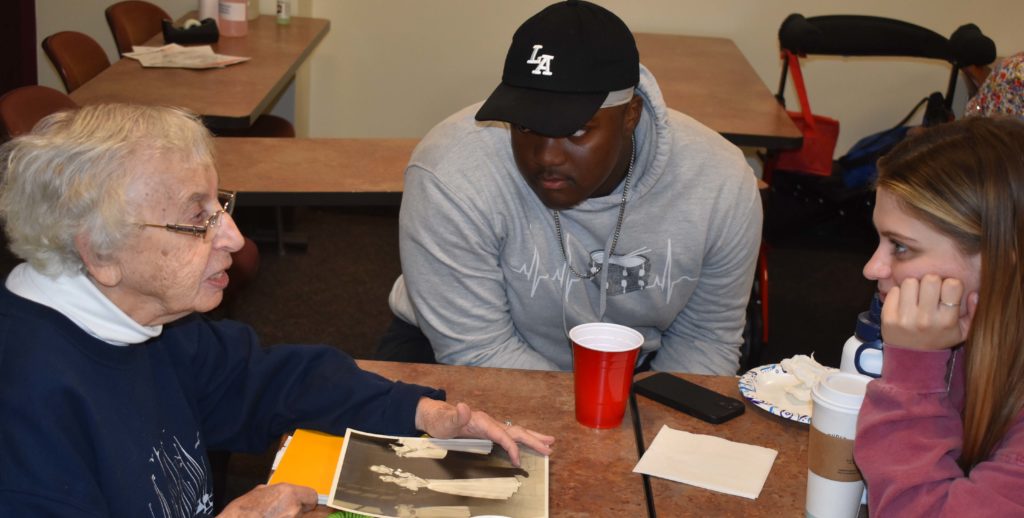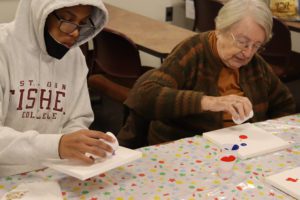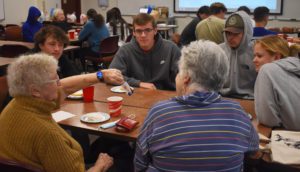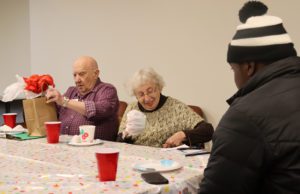St. John’s Residents Were the Missing Element for Chemistry of Love Class
What does anybody really know about love at 18 years old?
This was the challenge for Dr. Kimberly Chichester, associate professor of Chemistry at St. John Fisher University. When she started the CHEM 1077: Chemistry of Love course a couple of years ago, Dr. Chichester noticed a lot of slow starts to conversations about the different types of relationships covered in the curriculum. “Students weren’t raising their hands to answer questions,” she remembers, though she admits that was more a result of a lack of experience related to the subject matter as opposed to a deficit in knowledge or comprehension of the curriculum.
Dr. Chichester was worried that her course on love was trending towards a scenario she had long feared as an educator: that of “the teacher on stage and it is only their voice that matters.” She soon looked to her own experience as an undergraduate for a solution. “I took a class in college on the Holocaust that involved the public being students in the course alongside us,” she recalls. “The class stayed with me over 23 years because of the enriching conversations that came from it. The lessons were so much more impactful coming from survivors or participants in the events.”
This past Fall, Dr. Chichester’s class on love for first-year chemistry students evolved into the type of collaborative learning opportunity she had always hoped it would become. The missing element turned out to be a group of residents from nearby St. John’s independent living communities.

A wonderful chance to take a class with students
Leah Atwater worked in the chemistry department at University of Michigan before retiring in 1990. “I was in charge of the student service office,” explains Atwater, who now lives at St. John’s Meadows with her husband John. She was one of 12 residents over the age of 80 who participated in the Chemistry of Love class, traveling by bus to and from a half dozen class sessions throughout the Fall 2022 semester.

“I was surprised it was a scientist teaching about love,” said Atwater of her initial impressions of this new learning opportunity. Still, she says it quickly became clear why the “lifetime learners” from St. John’s were invited to take part in the class. “It was to give our take on love,” she explains. “She had specific questions for us to think about.”
According to the course syllabus, the class was meant to examine “the chemistry behind various types of love and how humans express those types of love.” The six special lab classes that St. John’s residents attended equaled about a third of the total Chemistry of Love sessions during the fall semester. Still, when they were on campus, the first-hand accounts they shared about categories like romantic love and familial love, paired with decades of self-reflection, provided the added perspective Dr. Chichester had envisioned. “It was important to me that students learn love comes in many forms and that community is an important relationship we must cultivate,” she said.
From party lines to Tinder: successful intergenerational work groups
Lani Pappano and Pat Seischab each brought eight decades of life experience to the St. John Fisher University class. Both were also teachers at one time—Pappano taught English in several other countries and an “ungraded primary” class in the New Orleans School District, Seischab as a business instructor at Medaille College and Rochester Institute of Technology. The two were grouped together with four first-year students throughout the semester.

“They talked a lot about themselves and their families. And so did we!” said Pappano about her experience in class; an account that illustrates what Dr. Chichester hoped this class would become. “I explained what a party line was. Well, they just thought that was from about 300 years ago,” the 82-year old explained with a laugh. “They kept asking questions and it gave them perspective—all four of them—of where they are in time.”
“I really just loved the group that we were in,” said Seischab. Married for 58 years to a now retired Biology professor, she admits she was not well-versed in some of the modern ways people are able to connect with each other. “The boys taught me about Tinder!” she said. “They said that was how some of them found love, and they couldn’t believe I didn’t know about Tinder. In a lot of ways, their worlds and our worlds are so different, so distant. I thought that’s where we bonded the most.”
Some of my closest friends are college football players

A year ago on Valentine’s Day, Don Bogdanski and Reva Sipser were featured in a 13 WHAM Bright Spot—one that described their own unique love story set at St. John’s Meadows. Both had previous relationships, but found comfort and companionship with each other later in life as they navigated life living in a senior living community.
Bogdanski and Sipser naturally joined the St. John Fisher University class, as both had previously been involved in many collaborative learning programs with local colleges and universities over the years at St. John’s. Unfortunately, just days after attending the final Chemistry of Love class on December 8, Reva Sipser passed away at the age of 95. At her memorial service at St. John’s Meadows later on in December, speakers talked about how this active resident who led a resident-run memoir writing class was “always up for doing something new and different” later in life. It was also mentioned that through the learning opportunities available at St. John’s, she was proud to become good friends with a number of college football players.
Many residents list these opportunities for greater learning and understanding among their favorite programs offered at St. John’s Meadows and Brickstone by St. John’s. These intergenerational learning programs have always been mutually beneficial, with research showing that both college-aged students and older adult participants have much to gain by participating.
For her part, Dr. Chichester considers her first attempt at connecting generations in the classroom as a success and hopes to replicate the experience again in the fall. “It is amazing how much more talking is done when the (St. John’s) seniors are in the room,” she said, though it sounds like those conversations continued even when they were not physically in the classroom. “I loved hearing the students talk about their senior classmates even when we met without them.”
